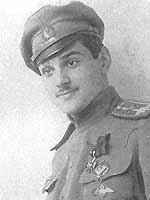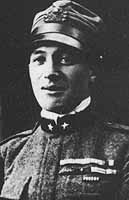Related Research Articles

Fulco VIII, Prince Ruffo di Calabria, 6th Duke of Guardia Lombarda was an Italian World War I flying ace and senator of the Kingdom from 1934 until his death. He was the father of Paola, Queen of the Belgians.

Cavalry Second Lieutenant Yury Vladimirovich Gilsher was a Russian fighter ace of World War I. Initially a cavalryman, but then an airman, Gilsher overcame two serious injuries to become an ace. After suffering a fracture of both bones in his right forearm, he later lost a foot to amputation because of a crash. He returned to duty with a prosthetic foot. Gilsher rose to his unit's command and scored five victories between April and July 1917 before being killed in action on 20 July 1917.

Flavio Torello Baracchini was an Italian World War I fighter ace credited with 21 confirmed and nine unconfirmed aerial victories. His confirmed victory total ranked him fourth among Italian aces of the war.

Capitaine Pavel Vladimirovich Argeyev, also known as Paul d'Argueev and The Eagle of Crimea, was a Russian-born flying ace of World War I, serving the French Armée de l'Air and Imperial Russian Air Service. Initially a high-ranking officer in the Imperial Russian Army, he transferred to France, where he became an aviator. He received a variety of decorations, both French and Russian, before dying in a flying accident in 1922.
Praporshik Aleksandr Mikhailovich Pishvanov was a World War I flying ace credited with five aerial victories. After an unsuccessful fight against the Communist takeover of Russia, he became an American citizen in 1928. His engineering skills were useful to both Sikorsky Aviation and to Seversky Aircraft Corporation from 1926 onwards. In 1942, he helped Walt Disney produce Victory Through Air Power to support the American war effort. Pishvanov's interest in aviation ended only with his death in New York City in 1964.

Lieutenant Eduard Martynovich Pulpe was a World War I flying ace credited with five aerial victories. He was a schoolteacher engaged in post-graduate study in France when World War I broke out. As he already held a civil pilot's license, he volunteered to serve in French military aviation. His 1915 aerial victories were among the first ever recorded. After running his score to four, he managed to return home to Russia in May 1916. He was assigned to the 10th Aviatsionniy Otryad Istrebitlei. After becoming an ace on 1 July 1916, he was killed in action a month later. On 2 August 1916, Eduard Pulpe ultimately lost a nearly hour-long air battle against three enemy aircraft.
Tenente Giovanni Sabelli was an Italian World War I flying ace credited with five aerial victories. At the start of World War I, he was already an experienced combat pilot.
Tenente Luigi Olivi (1894–1917) was an Italian World War I flying ace credited with six aerial victories. He won two awards of the Silver Medal for Military Valor and was killed in action.

Mario Stoppani was an Italian World War I flying ace credited with six aerial victories. His valor earned him two Silver awards of the Medal for Military Valor and the Russian Cross of St. George during World War I.
Captain Konstantin Konstantinovich Vakulovsky was a World War I flying ace credited with six aerial victories. A major general's son, he volunteered for aviation duty on 8 August 1914, six days after graduating from university. He taught himself to fly, and became one of Russia's first military pilots on 13 June 1915. After escaping the fall of the Novogeorgievsk Fortress in a hazardous flight, Vakylovsky flew reconnaissance missions, some through heavy ground fire. Given command of the newly formed First Fighter Detachment, he became a flying ace credited with six aerial victories. He died in a flying accident during Summer 1918.

PodpolkovnikYevgraf Nikolaevich Kruten was a World War I flying ace credited with seven aerial victories. He began World War I as an aerial observer with three years experience in military aviation. After a year's seasoning, he was recommended for, and graduated from, pilot's training in September 1914. He rose through the ranks, to be appointed as his unit's commander on 6 June 1916. With his victory tally at three, he was forwarded to service with the French Aéronautique Militaire. While learning French aerial tactics, Kruten shot down a German aircraft during February 1917. After his return to Russia in March 1917, he shared his new-found knowledge in a flurry of booklets on military aviation. He commanded his battle group of three detachments, and ran his victory total to seven before dying in a landing accident on 19 June 1917.
Captain Vladimir Ivanovich Strzhizhevsky was a World War I flying ace. He volunteered for military service on 14 October 1914, after graduation from Petrograd Technical Institute. Incomplete and confusing records credit him with eight confirmed and four unconfirmed aerial victories during his 1916-1917 combat on the Romanian Front. His second wound ended his tally of aerial victories. The advent of the October Revolution saw him co-opted into the Red Air Force for the end of the war. On 4 November 1918, he defected to the White Russian Army, and served with them for two years. When they were expelled from Russia, Strzhizhevsky accompanied them. He became a Yugoslav citizen and joined their air force.
Tenente Gastone Novelli was a World War I flying ace credited with eight aerial victories.
TenenteCarlo Francesco Lombardi known as Francis was a World War I flying ace credited with eight aerial victories. Postwar, he was active in his family's rice refinery, as well as in record breaking flights. He formed the AVIA aviation company in 1938.

Tenente colonnelloAlvaro Leonardi was a World War I Sottotenente from Italy and a flying ace credited with eight aerial victories.

Brigadier General Ferruccio Ranza began his military career as a World War I flying ace credited with seventeen confirmed victories and eight unconfirmed ones. Postwar, he rose to command of several area commands of the resurgent Italian Air Force. He served through the end of World War II.
Capitano Antonio Reali was an Italian World War I flying ace credited with eleven confirmed aerial victories, and 22 unconfirmed victories. He served in the Regia Aeronautica Reserves from 1923 to about 1940.
PraporshikGrigoriy Suk was a flying ace for the Imperial Russian Air Service during World War I.
77a Squadriglia was one of the first Italian fighter squadrons. After its founding on 31 May 1916, it began flying combat in July 1916, and would operate until the end of World War I. It was one of the squadrons drawn into late 1917's Battle of Caporetto, and forced to retreat after the Italian defeat. By the time the Austro-Hungarians sued for peace, 77a Squadriglia could count some 50 aerial victories scored in about 250 victories.

78a Squadriglia was one of the original Italian fighter squadrons of World War I, serving in combat from 29 June 1916 to 3 November 1918. They flew 4,770 combat missions and were credited with 88 aerial victories.
References
- Franks, Norman; Guest, Russell; Alegi, Gregory. Above the War Fronts: The British Two-seater Bomber Pilot and Observer Aces, the British Two-seater Fighter Observer Aces, and the Belgian, Italian, Austro-Hungarian and Russian Fighter Aces, 1914–1918: Volume 4 of Fighting Airmen of WWI Series: Volume 4 of Air Aces of WWI. Grub Street, 1997. ISBN 1-898697-56-6, ISBN 978-1-898697-56-5.
- Franks, Norman. Nieuport Aces of World War 1. Osprey Publishing, 2000. ISBN 1-85532-961-1, ISBN 978-1-85532-961-4.